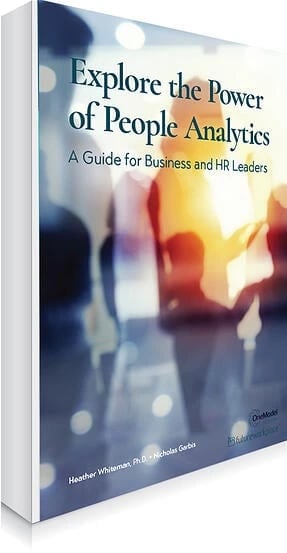Only humans would bother inventing something as complex as the concept of species. Attempting to organize every living thing around us into distinct buckets has been a massive and never-ending enterprise. We like categories and we love to argue about them!
What's the Difference between People Analytics and Reporting?
- HR Reporting and People Analytics are intertwined concepts which are more valuable when they are clearly articulated for their distinct purpose and value to the organization.
- Both are necessary for the effective management of the workforce and the HR processes that are aiming to achieve efficiency and employee/manager experience.
HR Reporting and People Analytics have been debated as being the same, as being different, as being parent-child and child-parent. So what’s all the fuss, and how can I offer some thinking that helps? Stirring up muddy water to make it become clear seems foolish, but here it goes.
Consider the word origins of the two key words:
- “Report” is based on the word “port” which means to carry something from one place to another. Reports share information.
- “Analytics” is based on the word “analyze” which means to decompose and recombine something into something that increases understanding. Analytics facilitates insight.
Both HR Reporting and People Analytics are built from a foundation of data that is generated by the multitude of systems-processes that exist within every organization. (See image below)

Most systems are built to facilitate processes (eg, hiring) and generate data as a valuable by-product (eg, job open and closed dates). Other systems such as survey systems exist solely for the purpose of generating valuable data.
What is HR Reporting?
HR Reporting can be generalized based on the traits it most commonly displays (accepting that these lines can be blurry, just as some plants can behave in ways that are quite a bit more like animals).
HR Reporting typically is ...
- Designed to provide information (versus insights)
- Simple in format, often as list or tables, possibly in a multi-tab spreadsheet
- Data is often from a single system (often, not always)
- Raw data, occasionally with calculations applied (i.e., metrics)
- Rather fixed in structure and limited in terms of user interactivity
- Used in monitoring transactional activity (e.g., list of currently open job postings)
- A source of data that is extracted for analysis in another tool (e.g., Excel)
- Could be a part of a larger People Analytics project
HR Reporting is used by:
- Process and technology owners (e.g., recruiting ops)
- HR functional leaders (e.g., learning or talent management leaders)
- People leaders (e.g., managers of teams)
- Executives (e.g., C-Suite, CHRO, VPs, DEI leaders)
HR Reporting is Valuable
HR Reporting is an essential point of access to the data within a given system, enabling the owners of the related processes to retrieve data for review and analysis. I can’t think of a system that doesn’t provide at least some access to the underlying data via reporting.
Reporting from these systems is typically organized into some set of pre-defined tabular views, each of them providing users with some options to filter the data to specific parts of the organization or process steps that they want to view (eg, course registrations for the Finance department).
- Metrics, which are calculations based on the raw data, may also appear in reports but will tend to be a summarization of the transactional data (eg, average time-to-fill for each recruiter).
- Trends of the data, perhaps displayed with different time periods in different columns, are also common and valuable.
Human Resources Reporting is distinguished from “analytics” because analytics tends to be aimed more at generating insights rather than sharing information. Let’s look at People Analytics next.
What is People Analytics?
People Analytics is more complicated to define. To begin with, it can represent:
- category of deliverables (eg, interactive dashboards),
- a team within the HR organization (eg, PA COE),
- a set of activities (ie, consulting & advising),
- or a combination of all of these.
For comparison with HR Reporting, which is a type of deliverable, we will focus on People Analytics as defined as a category of deliverables.
Maturity Continuum? No, Sorry.
HR Reporting and People Analytics do not belong on a maturity continuum, as they are both vital parts of running an organization well. Sure, if an organization has no People Analytics, you could confidently say they are less mature than another organization that does. You could even say that one organization’s People Analytics deliverables are more advanced (ie, mature) than another organization.
The point is, you don’t move from one level (HR Reporting) to another level (People Analytics) -- you need to deliver both and do them well, even if we agree that People Analytics will create more value for the organization.
Here’s a chart that may help orient the two:

Notice the difference in the objectives of each: People Analytics will be focused on generating insights. In fact, some advanced analytics solutions will have insights directly within the solution, but most often the insights are expected to occur when the user views and interacts with the content in the deliverable.
The value of People Analytics is more in the strategic realm, whereas HR Reporting generates more operational value focused on delivering information to keep the business running. Of course, there is some crossover, but generally, reporting helps with operational items such as efficiency, process monitoring and improvement, auditing, quality control, etc. Analytics is aimed at generating insights that will lead to decisions and actions. Analytics content is designed to facilitate valuable insights “at the speed of thought”, and in online settings this is achieved through interactive user experiences, issue highlighting, embedded insights using natural language. Analytics content facilitates hypothesis generation and testing simultaneously and is a learning and discovery vehicle for users.
Deliverables: People Analytics Projects, Products, and Services
Let’s outline People Analytics deliverables in terms of products, projects, and services. These are all aimed toward generating insights at scale that will drive the best quality, data-informed talent decisions. Systems and technology are not listed here because they are not deliverables, but enabling elements that help generate the deliverables.
Products
analytics content is most often distributed online via an analytics platform (like One Model), including metrics that may be sourced from multiple systems, and sometimes will have output from AI/ML predictive models.
- Dashboards / Storyboards -- an interactive collection of metrics with an explicit design goal of generating insights by or for the user. Some of this may be data science (AI/ML) results that are packaged for broader consumption. “Storyboards” are a variation designed, often with a question format, to elicit a story or path of thinking.
- Embedded Data Science -- AI/ML and modeling results that use HR data and are embedded within other products (eg, time-to-fill prediction that is consumed by recruiters directly within the recruiting system/ATS, or a restaffing projection rate within a project planning solution).
- HR Reporting -- while this is not ‘analytics’ in our working definition, it’s important to recognize that these deliverables are often part of the People Analytics team’s responsibility, so they are listed here so as to not be forgotten.
Projects
- Deep-dive studies: covering a given topic, possibly testing a hypothesis, usually culminating in a presentation or delivered document which contains data, metrics, visualizations, written insights, and even conclusions and recommended action steps. These may include advanced analytics and data science methods.
- Experiments and explorations: digging into the data to understand relationships further, test hypotheses, generate mock-up content that may go into productions, etc.
Services
- Evaluation: creating learning opportunities to elevate the analytics skills of partners (eg, HRBPs) in generic terms or specific to the People Analytics platform.
- Change Management: developing communications and user engagement plans to help drive adoption of tools and methods.
- Consulting: offering guidance on strategic decisions and programs that may be evaluated in response to insights generated through the PA team’s products and projects.
From Data to Deliverables
Let’s return to the diagram we shared in the previous section and expand on it a bit. The systems and processes that generate data are foundational to both.

Data from the multiple systems is selectively extracted into a data layer where data from multiple systems is integrated. This layer can be a standalone data warehouse (eg, in Azure or Snowflake) or can be part of a solution.
Metrics are calculated (eg, headcount, turnover rate) and dimensions are created (eg, organization unit, company tenure) by applying business rules against the data.
Dashboards and Storyboards are designed and developed within a visualization layer (eg, Tableau) or within a People Analytics solution.
Data Science will be done using data extracted from the warehouse into tools such as R or Python, or within the data science module in a People Analytics solution (only available in One Model at time of this article).
Analytics Projects will be combining elements of all the underlying pieces in what will become a presentation (written and/or verbal), usually on a key topic of interest to leadership.
Concluding Thoughts
As demonstrated above, HR Reporting and People Analytics are intertwined concepts which are more valuable when they are clearly articulated for their distinct purpose and value to the organization. Both are necessary for the effective management of the workforce and the Human Resources processes that are aiming to achieve efficiency and employee/manager experience.
- You don’t need to have perfect reporting before you begin doing analytics. The two can mature in tandem and are often mutually reinforcing.
- A robust, integrated, and flexible data foundation is going to provide the greatest value by ensuring the analytics deliverables do not ‘hit a ceiling’ where the next tier of value becomes unachievable without going back to the architecture of the data warehouse.
- Think “value first.” Obsess about how your team can generate the most value at the fastest pace for your organization, not about the arcane differences between commonly used terms.
To learn more about People Analytics, download a free copy of the eBook Explore the Power of People Analytics (value $8.99 in paperback on Amazon) I co-authored with Heather Whiteman, PhD.



